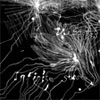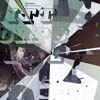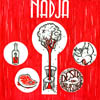- Administrator
- Albums and Singles
 As a collaboration between Telescopes founder/consistent member Stephen Lawrie and Vibracathedral Orchestra's Bridget Hayden, it bares little direct resemblance to the former's past work in rock oriented shoegaze and the latter's drone soundscapes. Instead it is a chaotic noise infused work that could shred the speakers with the best of them. Closer inspection, however, reveals that at the core, both artists show their pedigree, and that's what sets this apart from other similar records.
As a collaboration between Telescopes founder/consistent member Stephen Lawrie and Vibracathedral Orchestra's Bridget Hayden, it bares little direct resemblance to the former's past work in rock oriented shoegaze and the latter's drone soundscapes. Instead it is a chaotic noise infused work that could shred the speakers with the best of them. Closer inspection, however, reveals that at the core, both artists show their pedigree, and that's what sets this apart from other similar records.
Recorded in a room supposedly used by a psychic medium, the sessions were specifically recorded via environmental microphones, with the volumes set to the max. Undoubtedly this is what gives the record its raw distortion that, due to its dynamic noise quality that simply cannot be created via digital technology. While this sheen of noise covers almost every track, it doesn’t fully obscure the underlying performance and instrumentation. The opening track, "Static Charge," features a clatter that could be a metal shop, but is more likely a guitar track that has been amplified to the point of full distortion. It has a rhythmic sense to it (something many projects this close to the noise spectrum seem to forget), but is obviously due to playing, not looping. As the track wears on the gain is turned up to the point that full clipping is achieved, as sound starts getting cut out from the mix.
In some situations the noise is the dominant theme: “Thought Loops” starts out a bit less aggressive, but by the middle what sounds like a buzzsaw cuts into the mix and demands attention, and the track only becomes more harsh and chaotic from there. The closing “Chrome Gulls” also follows on this path to harsh noise-dom, with its unadulterated feedback and metallic high end ringing, which even though it has a more tense vibe than any other piece on here, eventually gives way to some treated, vast ambience at the end.
Others are less apt to focus on the noise and more on the underlying melodies that are obfuscated amongst the grime. “Northumberland” opens on a more melodic note and some melody is immediately apparent, even if the sound is that of a string quartet playing in the deepest depths of hell. “Tidal Bandwidth” is another track that is based around oversaturated tape recordings, but there’s a deeper, almost synth like pulse that gives a more melodic propensity.
A difficult album to pin down, because it does feature elements of dissonance, but those are equally met by subtle melodic parts that could be easily ignored. For all its harshness, it is a complex album that is worth exploring the layers of.
samples:
Read More
- Administrator
- Albums and Singles
 Methadrone is New Jersey-based Craig Pillard, and Sterility is his third album recorded under that name. Sterility brings us eight exquisite examples of the grungy and oppressive bass-heavy dronescapes, augmented by acoustic guitar and vocal elements, that Pillard has made the trademark of Methadrone. Never has doom and darkess been encapsulated so appealingly.
Methadrone is New Jersey-based Craig Pillard, and Sterility is his third album recorded under that name. Sterility brings us eight exquisite examples of the grungy and oppressive bass-heavy dronescapes, augmented by acoustic guitar and vocal elements, that Pillard has made the trademark of Methadrone. Never has doom and darkess been encapsulated so appealingly.
The name Methadrone has been lurking around the periphery of my awareness for quite some while now, but this is the first time I have encountered their music. Being naturally attracted to the darker, dronier, ambient end of the spectrum, this shoehorns itself quite easily into that category, and appeals to me on so many levels. The music is anything but sterile. For starters, there’s the inherent simplicity: it’s not complex music when broken down into its constituent parts, but in combination equals something deep and shiver-inducing. Indeed, I would even go so far as to characterize this as symphonic, and like any good symphony, has an innate power to move. In addition, this symphonic character transcends the usual stereotypical cod-classical that pervades the doom metal regions and displays a maturity, emotionally and musically, that elevates it above that norm. The use of acoustic guitar, along with the vocals of David Galas on two tracks and Pillard’s own voice on track six, paints a picture of an exotic creature, startling yet dangerously beautiful.
Album opener and title track “Sterility” is a perfect exemplar of how Pillard creates that distinctive ambience. Essentially composed of just a few layers, a drone backing running beneath a synthetic choir weaving its voice around a weft of alternating bass and bright treble guitar chords, the dense sedimentary nature of the piece nevertheless amplifies the power inherent in each layer. This signature can also be found in “Cominium of Desire” and “Horizone.” The former is probably the nearest this album offers to a conventional song, with darkwave singer David Galas’ treated voice lending a plaintive unearthly dimension. “Horizone,” aside from being my favorite track, transfixes the heaviest elements of slow-doom and melancholic romanticism into a tapestry depicting the twilight of the gods. A downtempo eight-minute epic mixing those ubiquitous acoustic chords, electronic voices, bass percussion and Pillard’s wordless voicings, this has elements of Robin Guthrie’s work for Cocteau Twins threading its influences around the entire piece. It’s a slow-dying heartbeat, waiting for the darkness to finally overwhelm the consciousness.
The one track that seems to be slightly out of place, at least for me, is the 16-minute closer. This departs from the normal run of things, and comes perilously close to being a true instrumental in the way most would recognise it. Simultaneously it’s undeniably a Methadrone track for all its difference of approach. Electric guitar takes centre-stage on this one, with some discernible riffage readily apparent from the very start. Slow-beat drums pin everything into place, while some high-flying guitar soars stratospherically above the dense drone background. However, as different in its way as it is from the rest of the album, it is still an inseparable part of the constitution of Sterility.
It's hard for me not to wax enthusiastic about this one. For me, this has all the elements necessary to appeal on every level, and to elevate it above the everyday. It is exquisite, expansive, erudite, and just stunningly beautiful. For me that’s all I need.
Samples:
Read More
- Administrator
- Albums and Singles
 For their second release, FSS has resurrected a 1987 album by this Dutch trio. This was actually their second album, with their debut LP, Hartgore, oozing into the light of day in 1986. The trio, made up of drummer Danny Arnold, guitarist Pieter De Sury, and bassist Marij Hel, further perfected their mean, muscular, and down’n’dirty sound only a year on from that on this second platter. Now, 21 years later, it gets a welcome re-release in the form of a digital download as well as a limited edition vinyl LP.
For their second release, FSS has resurrected a 1987 album by this Dutch trio. This was actually their second album, with their debut LP, Hartgore, oozing into the light of day in 1986. The trio, made up of drummer Danny Arnold, guitarist Pieter De Sury, and bassist Marij Hel, further perfected their mean, muscular, and down’n’dirty sound only a year on from that on this second platter. Now, 21 years later, it gets a welcome re-release in the form of a digital download as well as a limited edition vinyl LP.
It is a very simple formula—powerhouse drums pounding along forcefully, anchoring the sound firmly, backed up by driving bass lines with a chainsaw guitar cutting through equally forcefully. It all adds up to a gargantuan entity rampaging under its own not inconsiderable steam. There’s no recourse to finesse here—it is straight-forward no-nonsense pile-driving grunge. For all that though, it would be fair to say that in many ways (and bearing in mind this was recorded in the late '80s) it paved the way for many bands that followed. Certainly the filthy gutter-bred sound, so familiar now, would have been quite innovative at the time.
To take a typical example of what is on offer here, “Loaded,” is probably wholly representative of the behemoth that is Gore. Immediately cutting to the chase, a feedback-ridden power-chord introduces the song before an adrenaline-pumping bass-drum kicks in, kick-starting the six-string chainsaw buzz into action. The bass performs its task admirably, keeping pace and providing a solid vehicle for the twin-engines of the guitar and drums. The sandpaper abrasiveness of De Sury’s guitar commands attention from the get-go, igniting the furnace and sending sparks everywhere. The relentless heat is constantly fed by the pulsing percussion, turbo-charging it ever onwards without let or hindrance. The two ensuing pieces, “Meat Machine” and “Out for Sex,” continue the frenetic headlong dash into nuclear oblivion.
To be entirely fair though, this absolute disregard for any kind of sonic restraint typifies this album. From the very outset, Gore stake out their claim to the very heart of a particular slice of territory in the musical landscape. Moreover, they have no intentions of ever giving any ground, at least not without a fight, obviously subscribing to the philosophy that just by sheer overwhelming force of personality they can stop all opposition in their tracks. However, what is more important, in my view, is the fact that Gore here created a template for others to follow. Without their example adding to music’s gene-pool, it may be that many would never have been inspired to tread the same path.
On the downside, if indeed there is one, I admit that in some respects there’s a slight datedness to this. Despite that proviso, overall I would say that even so it points the way to the origins of this particular genre. Even though it could be said that it is most certainly of its time, it is absolutely no less listenable because of that. In fact, I would even would wager that there are one or two bands who will be able to mine it for inspiration even today.
Samples:
Read More
- Administrator
- Albums and Singles
 Here's a self-released EP from a duo delivering on the promise of their self-titled debut. The title track, which could teach Milan Kundera a trick or two about how to deal with philosophical questions in a populist style, has made my musical year.
Here's a self-released EP from a duo delivering on the promise of their self-titled debut. The title track, which could teach Milan Kundera a trick or two about how to deal with philosophical questions in a populist style, has made my musical year.
At the risk of sounding like a preview for the any of Harrison Ford’s ill-judged cinematic attempts to justify US foreign policy, Phil Rollins and Matt Resignola are The Gubernatorial Candidates. Their 2007 debut album (also self-released) showed them shaping songs through a shedding and donning of influences. That process continues with impressive results and head-scratching frustration on No Remainder.
First the annoyance: “Pyongyang” is far too short. Resignola wrests plenty of interest from a few hard edged acoustic guitar notes and a little processing but the overall impression is of a brief postcard from a Deep South equivalent of the Penguin Café. It's not a bad place to be, come to think of it. Except the track gives the impression we have arrived just as they are closing.
“Coffin (version)” is the latest of Rollins’ attempts to manufacture a vaguely African pulse into an effective pop-serialism; and he may ask himself, well, how did I get here? The single guitar riff, looped and repeated with a harmonic middle section is intriguing but ultimately it seems like a watercolor Reich-by-numbers with far too few numbers. It's worth remembering that Reich’s apparent simplicity is based on a rigid theoretical complexity and an astute sense of what to discard and what to explore. While the actual notes on "Coffin" do sound good, the piece doesn't bear repeated listens and ultimately amounts to the equivalent of a miniscule piece of rejected tape from the My Life in the Bush Of Ghosts sessions, at best. Plaudits for having the taste to try, but...
All is forgiven with “No Remainder” itself. This is a shimmering gem of which David Sylvian or Paul Buchanan might not be ashamed. All the better that, unless it gets scooped for a movie soundtrack, it will remain a largely unheard treasure. It needn't be that way, as sometimes the mainstream and the obscure can intersect: I recall the pre-mega Madonna listing The Book of Laughter and Forgetting as her favorite so perhaps she can tell Guy to get this onboard for his next project. Either that or maybe the hapless Ford will mistake it for a pro-Nationalism thumbs-up. Stranger things have happened. Along the way, Rollins’ voice gets glitched by Resignola's nifty autotuning and the latter also slowly builds the dynamic with a rather fantastic wall of fuzzy guitar. The voice is good enough to stand alone but the glitching adds a sense of humans as machinery and of a relationship or system that is broken. The oblique song sounds part death knell part defiant celebration with clever lyrics which raise more questions on the unintended dehumanizing consequences of love and politics than Milan Kundera has answered in all of his novels. In the unlikely event, this will be my inauguration soundtrack.
samples:
Read More
- Administrator
- Albums and Singles
 This is the first time Poland’s Zbigniew Karkowski (currently based in Japan) has released a collaboration with America’s Damion Romero. Both artists have a huge (and often overlapping) list of former partners in crime so it was probably inevitable that they would cross paths. It is a good job they did because this album is one of the best noise albums of the year. Although noise is probably a poor description of it: non-musical, alleatoric experiments in mood being a bit more precise. This is not an exercise in deafening sound but an exploration of low frequency sounds and moving a lot of air with a speaker system.
This is the first time Poland’s Zbigniew Karkowski (currently based in Japan) has released a collaboration with America’s Damion Romero. Both artists have a huge (and often overlapping) list of former partners in crime so it was probably inevitable that they would cross paths. It is a good job they did because this album is one of the best noise albums of the year. Although noise is probably a poor description of it: non-musical, alleatoric experiments in mood being a bit more precise. This is not an exercise in deafening sound but an exploration of low frequency sounds and moving a lot of air with a speaker system.
The feelings that arise during 9 Before 9 are those of emptiness, solitariness and space. It is the sound of the hum that makes up the background radiation of space somehow picked up on a normal stereo. At low volumes, 9 Before 9 has very little going on but once the volume is pushed up the bass-heavy rumble fills the room. It is an underlying noise, like the sound of plane when you become accustomed to it during a flight, easy to ignore but fascinating once it is given some attention.
The album is split into three untitled 18 minute parts. The first part sounds the most like the in flight jet engine sound described above. As the piece creeps to a close, pops and crackles appear which add an occasional textural change to the piece. Near the end, the sound becomes unsettling, less like an everyday background noise and more like the beast lurking on the other side of reality. This other side becomes more evident with the second part, the low drone changes to a shifting buzz sounding like the world’s biggest and most pissed off bees. Buried in the mix is the sound of wind and rain but the drips of rain sounds more like a wet chewing sound in this context than drops of water.
The third and final part of 9 Before 9 takes things down a notch, bass pulses again become the predominant feature of the music. Metallic rasping covers the piece like dust in an old room and below the floorboards of this room come sounds that are either a radio being played in a room below (muffled and incomprehensible) or the sound of something unnatural moving about. The uneasiness that Karkowski and Romero pull from what sounds like very few sources is remarkable; compared to the sheer force needed by other artists to cause a similar amount of unease Karkowski and Romero make it seem simple.
samples:
Read More
- Administrator
- Albums and Singles
 The debut album from Nashville's Sub-ID combines electronics with jazz and hip hop sensibilities. Their blend of acoustic and electronic instruments is seamless, effectively blurring the line between the two. Yet despite the high production values, too often the songs themselves lack distinction and instead settle for a generic middling of their influences.
The debut album from Nashville's Sub-ID combines electronics with jazz and hip hop sensibilities. Their blend of acoustic and electronic instruments is seamless, effectively blurring the line between the two. Yet despite the high production values, too often the songs themselves lack distinction and instead settle for a generic middling of their influences.
Jazz is obviously a big part of the group's aesthetic, but sequencers are no contest for live musicians, especially when they're programmed in such a traditional fashion. The songwriting sounds too constricted and lacks the spontaneity inherent in quality jazz. The live trumpet sprinkled throughout the album sounds great, but without any suitable counterpart, its efforts are somewhat muted. There are some moments of electronic exploration, like on "Marges," but they're so few and far between that they can't save the album's lack of momentum.
Because these songs are so easy on the ear, many of them are better suited for the background than attentive listening. As an album of mostly instrumentals, it's hard to say what the group is trying to express other than a mellow vibe, which isn't saying much. Vocalese appears toward the end of the album, which enhances the songs but doesn't quite provide the direction they're lacking. The album's best songs are "Yup 1" and "The Return." The former most fully realizes the potential in crossing jazz and electronics while the latter provides the album's only real excitement.
The most frustrating thing about BFF is that it's not bad, merely boring. Sub-ID plays it safe with their debut at the expense of any true innovation.
samples:
Read More
- Administrator
- Albums and Singles
 Blending concrete sounds with electronics and homemade instruments, the success of Anakrid's latest album hinges on its unpredictability. New, strange sounds lurk around every corner, ready to subvert expectations by adding a spontaneous rhythm, dropping the volume, or the arrival a sudden arrhythmic crash. The result is a frequently bewildering yet thoroughly entertaining recording.
Blending concrete sounds with electronics and homemade instruments, the success of Anakrid's latest album hinges on its unpredictability. New, strange sounds lurk around every corner, ready to subvert expectations by adding a spontaneous rhythm, dropping the volume, or the arrival a sudden arrhythmic crash. The result is a frequently bewildering yet thoroughly entertaining recording.
Anakrid gets the most out of stereo, creating a dynamic sense of movement and dynamism between the channels. In fact, there are so many different sounds between left and right that sometimes the tracks seem governed by schizophrenia. This is especially apparent on "The Examinatione," which is almost like two separate mono songs added together to create stereo. Yet they're not entirely dissimilar, their abstract qualities complementing each other for mesmeric effect.
While the album's tracks don't bear a whole lot of relation to each other, they do have some things in common. Metallic overtones form the backdrop of several songs, while beats appear with some regularity, especially on the latter half of the album on tracks like "The Guttenberg Galaxy" and "Cinder Your Eye." If anything, it's the group's aesthetic sense that gives the album its coherence.
Although humor isn't a huge part of this album, glimmers of it come through the juxtaposition of unlikely and unrelated sound sources. It's hard not to smile when the imploding industrial rhythms of "Limited Liability Processing Plant" give way to the soft melody of "Lies on a Tranquil Brow" or when the disruptive squeaks and blurts on "The Many Voices of Reason" lead into the pulsing bass throb of "The Outer Beings."
Far from a hazy collage, there's a sense that everything on Banishment Rituals comes from a high level of purposeful articulation and control. With songs ranging from a minute and a half to nearly seven minutes, there's no room for filler here. With little space between tracks, the album moves in a breezy manner, giving the misconception that all this hard work was natural and effortless.
samples:
Read More
- Matthew Amundsen
- Albums and Singles
Pianist Paul Grabowsky is probably the biggest name in the group, having played with such greats as Chet Baker and Art Farmer, but the other musicians-Scott Tinkler, Philip Rex, John Rodgers, and Ken Edie-come with their own impressive resumes. Even though most of these players come from a jazz background, the resulting music is as much influenced by classical music as jazz, an impression reinforced by the addition of a violinist.
The group strays quite a bit from the jazz idiom and seems instead to rely on instinct as its guiding force. Rather than playing riffs or motifs, the players attack their instruments to elicit new sounds from them. For example, the groaning trumpet on "Conference of the Baboons" sounds alternately like an elephant and a chair slowly scraping along the floor while the double bass throbs in sympathy. The title track is the most frenzied cut, the violin in particular becoming nearly violent in its expression. There's definitely some fat that could have been trimmed from this recording.
The first few songs sound like the group was merely warming up, and they're not really clicking until halfway through the third track. Even so, there's plenty of ferocious and innovative playing all over this album to erase any of its flaws.
Read More
- Matthew Amundsen
- Albums and Singles
The album gets off to a slow start. "Line" meanders with clicks, feedback, and awkward thumps before settling into a subtle melodic loop. Unfortunately, the monotonous preamble blunts its effectiveness. "Meguro" is better with its wavering drones and simple yet elegant recurring melody, but the pops and clicks that dot the track are too distracting for it to be completely enjoyable.
However, the album gets a lot better starting with "Fbk1," which uses prolonged hums, distorted sounds, and hazy pitches to create music that's peaceful and absorbing. "Fbk2" uses similar ingredients but the result is more like an underwater dream. "Recaptcha" is the album's most frenetic track with its rapid looping melody, yet it still retains the contemplative beauty found on the album's better compositions.
The best parts of the album weave together effortlessly. While the first two tracks seem out of place, the rest of Maju-5 is nearly flawless.
Read More
- Administrator
- Albums and Singles
 This disc of Norwegian psychedelia is much different than the kind other countries put out. Instead of sloppy stabs at slow repetition, there is instead four sprawling tracks of constantly shifting musicality that show obvious influences of psychedelics, new wave, classic and post-rock. However, the actual result isn’t as bizarre as it could be.
This disc of Norwegian psychedelia is much different than the kind other countries put out. Instead of sloppy stabs at slow repetition, there is instead four sprawling tracks of constantly shifting musicality that show obvious influences of psychedelics, new wave, classic and post-rock. However, the actual result isn’t as bizarre as it could be.
When the title track is listed as a “suite,” there’s a good bet that there is some level of pretense going on here, and there is a bit of that whole “we like odd time signatures and complex structures” thing going on, but within reasonable boundaries. Not quite Coheed and Cambria, but Motorpsycho does flaunt their obtuseness. “Suite: Little Lucid Moments” opens in a very conventional way with its guitar/bass/drums structure and clear, unprocessed vocals that seem out of place on any song with a 21+ minute duration. The changes become pretty obvious though, as the track segues in and out to its four specific parts, some more overt rock, others purely experimental.
“She Left on the Sun Ship” leans a bit less of a focus on the complexity and more focus on simply 'rocking,' with its hard rock color and more basic structure: front half of the track is the heavier rock material, while the latter part is more sparse and mellow in comparison. The overall sound of it is not drastically different from the first parts of the first track, but it tends not to change up very much.
The overarching post-rock (emphasis more on 'rock' than 'post') vibe is not unsurprising on an album of 4 long tracks such as this, but the execution is more conventional and predicable than bands of a similar ilk. One of the overall flaws about this work is that, for all intents and purposes, it doesn’t push the envelope as much as it could. There are good ideas here, but as a whole it stays too close to normalcy rather than going out in left field, which would have served it better.
While there are some unique contrasts in this album, the overall feel is one of sameness, which hurts it as a whole. The odd combination of '70s classic rock guitar that opens “The Alchemyst” being mixed with a rhythm section that has more in common with early '80s post-punk makes for an interesting contrast, but the compelling moments are too few and far between overall. The skill and execution are definitely here, but the ideas just seem to be lacking somewhat.
samples:
Read More
- Administrator
- Albums and Singles
 Although many (myself included) have accused this duo of being overly prolific and simply releasing every bit of recorded material that exists. While this is still a debatable case, this new full length album feels much more fleshed out and conceived when compared to some of their other works, and the addition of live drums on a few of the tracks doesn’t hurt either.
Although many (myself included) have accused this duo of being overly prolific and simply releasing every bit of recorded material that exists. While this is still a debatable case, this new full length album feels much more fleshed out and conceived when compared to some of their other works, and the addition of live drums on a few of the tracks doesn’t hurt either.
I must admit in most cases of being a fan of the ol’ drum machine. There’s something about repetitive, stiff beats that usually catches my ear. In the case of some of Nadja’s previous work, the monotone rhythms clashed with the often frozen, stagnant guitars and thus slid into a rut of repetition that felt as if it never went anywhere. The live drums that cover most of the first half of this disc would stop that from happening, because the shifting, more idiosyncratic rhythms give the tracks greater propulsion than earlier works had.
This is not quite as necessary as it could have been on previous stuff, because although the elements of drone are clearly present, the tracks are more apt to switch up instrumentation and layering to give a greater dynamicism: “Sign-Expressions” clocks in as one of the longer tracks, but the layers of treated guitar continue to vary throughout, so although it is based on significant amounts of repetition, the subtle changes go a long way.
There is also a notable amount of divergence from the norm and variety going on, the aforementioned “Sign-Expressions” opens with a sluggish rhythm section from an early Swans record, but picks up the pace as the track goes on an adopts an almost jazz quality that is definitely different, but still fits in nicely. The shorter “Affective Fields” is an even greater stab at trying something different, as it is almost entirely focused on the bass and drums, the guitar and noisier elements remaining hidden deep in the mix, giving the track more of a dub quality than most.
The last two, “Uneasy Desire” and “Deterritorialization” are more “traditional” Nadja, and from the sound of things they dusted off the drum machine for these two. However, the programming is appreciably diversified, and the careful layering and looping of guitars and effects are more varied and composed than other works. The latter even delves more into abrasive industrial textures that are more overt than on other tracks.
Admittedly, I’d still prefer a slightly different color to the guitar effects: they remain too caught in the mid-frequencies and just feel a bit anemic, that is purely a matter of personal preference, and in this case it is hardly a detriment with so much else going on around it. While I approached this album with some cynical trepidation, I definitely came out proved wrong in a good way.
samples:
Read More

